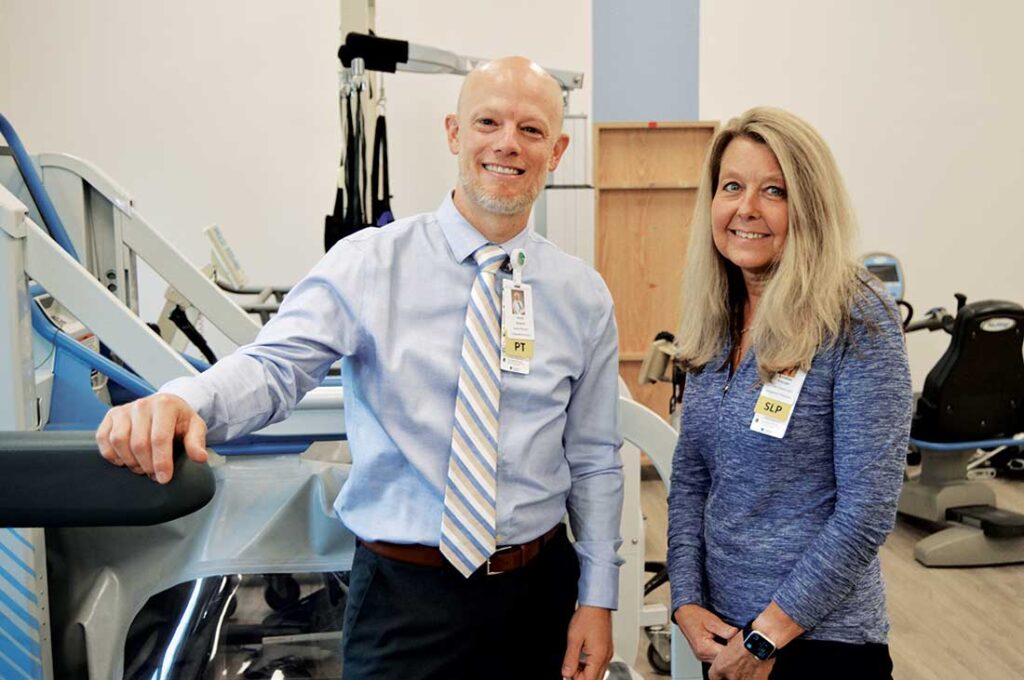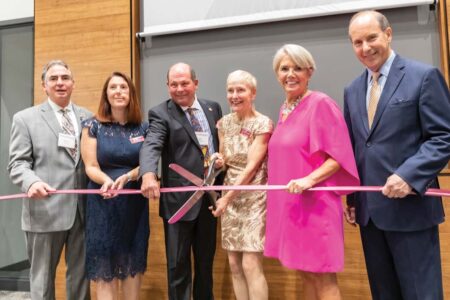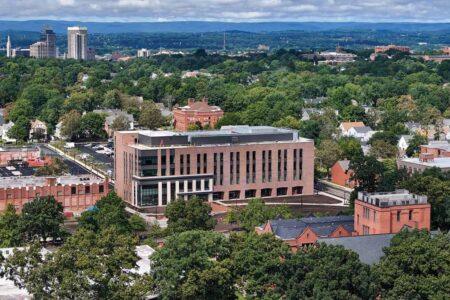Pointing to a valued approach
Long-term acute care affiliate provides an interdisciplinary model that Springfield College — and its new Health Sciences Center — wholeheartedly support
Kimberly Levesque PT, DPT ’16, G’18 offers guidance and support to a patient.
Kimberly Levesque PT, DPT ’16, G’18 offers guidance and support to a patient.
Kimberly Levesque, PT, DPT ’16, G’18 is a physical therapist who provides rehabilitation care that ranges from post-surgical and complex medical cases to helping those who wish to return to a sport.
Working for a Gaylord Specialty Healthcare outpatient orthopedic clinic in Cheshire, Connecticut, Levesque is immersed in a patient-centered team approach, working with and alongside multiple disciplines from physician assistants, medical doctors, and physiatrists to social workers, other physical therapists, and occupational therapists and staff in nutrition.
That’s because Gaylord excels at providing interdisciplinary care centered on the patient’s needs — a model Springfield College students are practicing in the new Health Sciences Center. (See story starting on page 10.)
A long-term acute care hospital in Wallingford, Connecticut, with outpatient facilities in the region as well, Gaylord is widely recognized for its leadership in treating patients with complex medical needs in a collaborative approach that draws all team members together in consultation and in practice.
“Springfield College’s new Health Sciences Center will allow for authentic interactions between these professional students and help them interact and adapt through this journey.”
Kimberly Levesque, PT, DPT ’16, G’18
Jacob Hunter PT, MSPT, senior director of outpatient clinical services, explains, for instance, that a patient with a brain injury who is working on balance, gait, cognitive function, and task-orientation would be treated with a team approach consisting of physical, occupational, and speech therapists with the support of care management — precisely how Springfield College students will learn within the walls of the new Health Sciences Center. They would meet for Team Treating Conferences to discuss patient goals from each discipline’s perspective and talk about progression, reporting to physicians.
Every facet of Gaylord’s structure supports this teamwork with settings designed for intentional interactions between disciplines. Offices for OTs and PTs in both the inpatient and outpatient departments are open to allow for natural communication. In treatment areas, “patients working with a physical therapist can see their occupational therapist across the gym,” Hunter said. “The idea is that the patient feels like we’re all in this together.”
That’s an idea Springfield College — and its new Health Science Center — wholeheartedly support.
The College and Gaylord have a long-term affiliation. Many health science students have completed internships at Gaylord, training in its approach, and many have been hired after graduation. Ten physical and occupational therapists who are all Springfield alums are currently working at Gaylord, and two interns, one PT and one OT, are slated to come on board in the fall.

Levesque said Springfield College trained her well for Gaylord’s collaborative model. “The College taught us to be more than just students and focus on academia. It showed us how much more there is to life and the importance of helping others in and around our communities,” she said. “This has helped me extend compassion and passion to every individual I meet and go above and beyond for the people who rely on me every day while staying grounded in who I am as an individual.”
Another Springfield College alum, Andrew McIsaac, PT, DPT, ’10, G’12 has been with Gaylord for six years in a variety of positions and is currently the clinic supervisor for two outpatient physical therapy locations. He provides patient care roughly half the week and interfaces with a wide range of administrators the other half.
The most gratifying part of his work is returning patients to activities they thought they might never participate in again, which can range from participation in sports to something as simple as carrying the groceries in from the car.
McIsaac believes the new Health Science Center will greatly enhance current students’ capacity for learning and collaboration. He said, “Increasing interdisciplinary contact by holding classes and study sessions in a common area will drive increased cross-communication and comfort with other disciplines, helping everybody to row the boat in the same direction. Once we begin to do that consistently in the health sciences, the sky is the limit.”
Levesque is likewise thrilled with the new center. She said, “It will allow for authentic interactions between these professional students and help them interact and adapt through this journey, which will allow them to be the best clinicians they can be when they graduate because they will have been immersed in this experience.” ![]()




